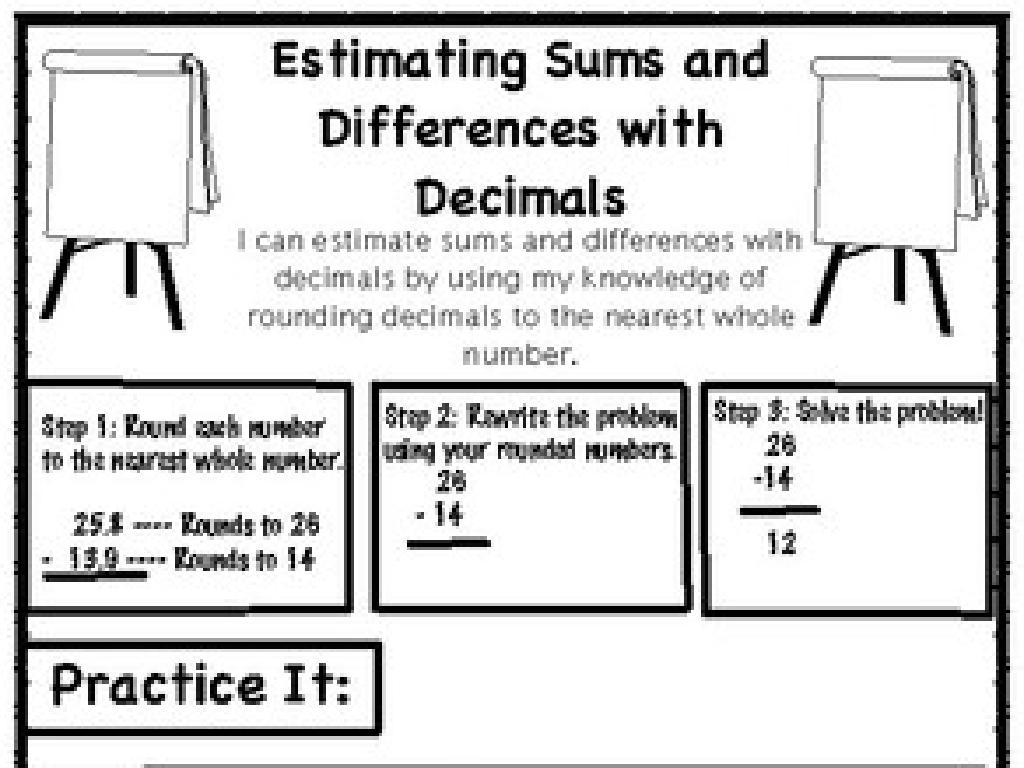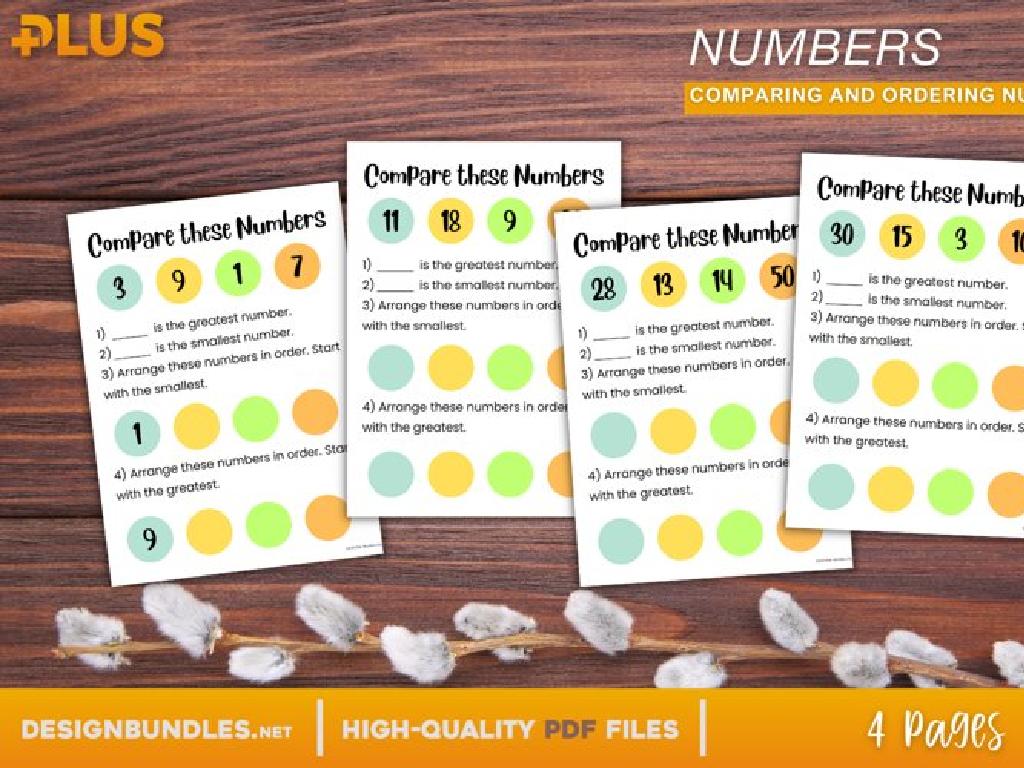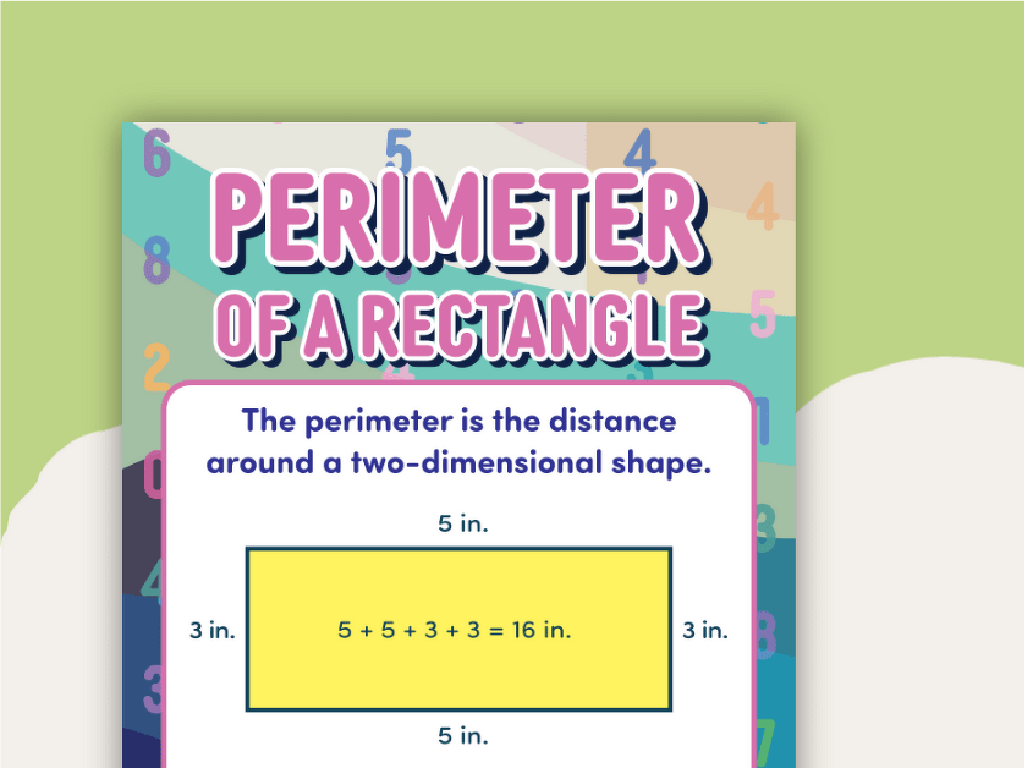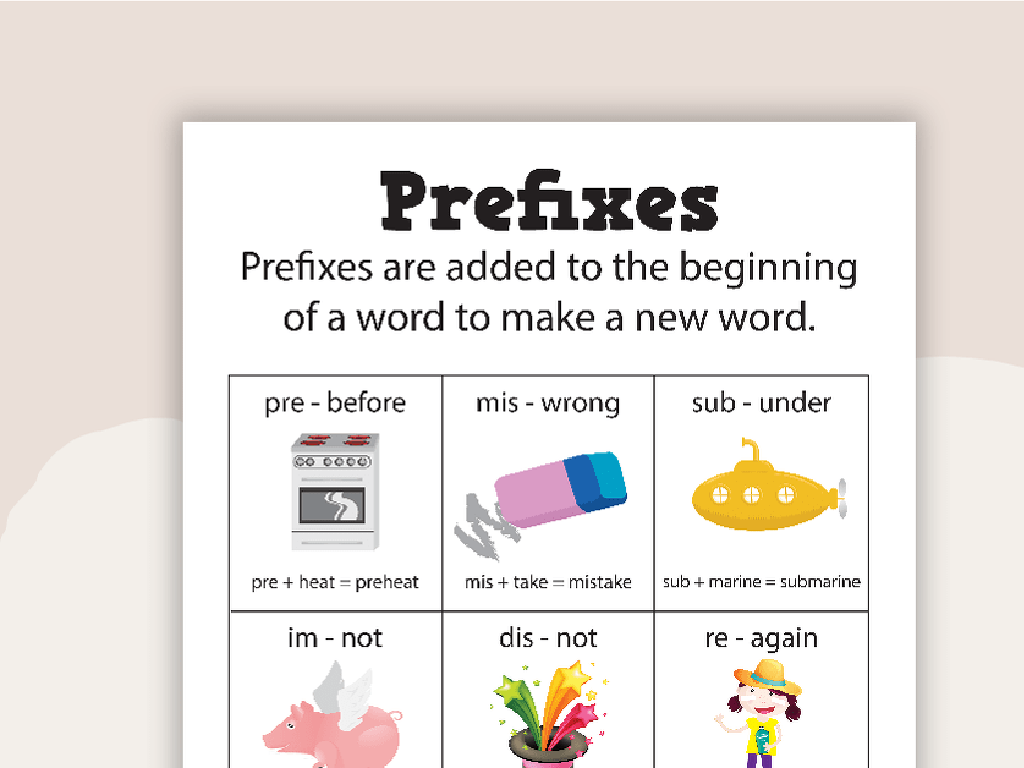Compare Numbers In Tables
Subject: Math
Grade: Fourth grade
Topic: Ordering And Comparing
Please LOG IN to download the presentation. Access is available to registered users only.
View More Content
Comparing Numbers in Tables
– Learn to compare numbers in tables
– Ordering and comparing in daily life
– Helps with making decisions, organizing information, and more
– Why is comparing numbers important?
– Think about shopping, scoring in games, or measuring heights
– Class discussion and examples
|
This slide introduces the concept of comparing numbers within tables, an essential skill in mathematics that has practical applications in everyday life. Start by explaining how tables are used to organize numbers for comparison. Emphasize real-life situations where comparing numbers is crucial, such as determining the best-priced item when shopping or understanding sports scores. Ask the class to provide examples of when they have compared numbers and why it was important in that context. This will help students relate the concept to their own experiences. Encourage participation and facilitate a discussion to ensure students grasp the significance of the lesson. Prepare to provide examples such as comparing test scores, temperatures, or distances to solidify understanding.
Comparing Numbers in Tables
– Understanding comparison
– Comparing means finding which number is bigger, smaller, or if they’re the same.
– Symbols: >, ): 5 > 3, Less than (<): 2 < 4, Equal to (=): 6 = 6
– Examples of comparing numbers
– Compare 45 and 32 using symbols, or 56 to 56 to show equality.
– Practice with comparison
|
This slide introduces the concept of comparison in mathematics, which is a fundamental skill in understanding numerical relationships. Start by explaining that comparing is about evaluating the size of numbers relative to each other. Introduce the symbols for greater than, less than, and equal to, and ensure students understand what each symbol represents. Use clear examples to demonstrate how to compare two numbers and decide which symbol to use. Encourage students to practice by comparing numbers in tables and identifying patterns. This will help them develop critical thinking skills and improve their ability to analyze data.
Using Tables to Compare Numbers
– Tables organize numbers for comparison
– Like a treasure map, tables guide us to see which numbers are bigger or smaller.
– Learn to compare numbers in tables
– We’ll become detectives, finding clues in rows and columns to see which numbers win.
– Practice with a provided table
– I’ll show you a table, and we’ll play a game to spot the differences together.
|
This slide introduces the concept of using tables to compare numbers, which is a fundamental skill in understanding data organization and comparison. Emphasize the importance of tables as a tool for visual organization that makes it easier to compare and contrast numerical information. During the lesson, guide students through the process of examining tables and identifying which numbers are larger or smaller. Use the provided table to engage students in a hands-on activity where they can apply what they’ve learned by comparing sets of numbers. Encourage participation and assist students who may have difficulty understanding the concept. The goal is to ensure that by the end of the practice, all students can confidently use tables to compare numbers.
Comparing Numbers in Tables
– Understand comparison symbols
– Symbols: > (greater), < (less), = (equal)
– Analyze two-column number table
– Look at the table provided
– Compare numbers row by row
– Use symbols to show which number is bigger
– Practice with an example
– I'll demonstrate the first comparison
|
This slide is aimed at teaching students how to compare numbers within a table using comparison symbols. Start by explaining the meaning of the symbols for greater than, less than, and equal to. Show students a table with two columns of numbers and guide them on how to compare the numbers in each row. Demonstrate the first comparison as an example. Then, encourage the students to try the next one on their own. Provide immediate feedback and support as they work through the activity. This exercise will help reinforce their understanding of numerical order and prepare them for more complex comparisons in the future.
Practice Time: Comparing Numbers in Tables
– Try comparing numbers in a table
– Use , and = symbols correctly
– For example, if 34 > 23, then 34 is greater than 23
– Work independently first
– We’ll review as a class afterwards
|
This slide is designed to engage students in a hands-on activity where they apply their knowledge of comparing numbers using comparison symbols. Provide a table with two columns of numbers for students to compare. Remind them to use the symbols for ‘less than’, ‘greater than’, and ‘equal to’ correctly. Allow students to work independently to foster problem-solving skills. After sufficient time, regroup as a class to review the answers, discuss any difficulties, and reinforce learning. Offer praise for effort and correct usage of symbols, and provide guidance where needed. This activity will help solidify their understanding of numerical comparisons in a practical context.
Comparing Numbers with a Number Line
– Understanding ‘>’ and ” means more than, ‘ 3 because 5 is to the right of 3
– Numbers left are less
– Like 2 < 4 because 2 is to the left of 4
|
This slide is aimed at helping fourth-grade students understand the concepts of greater than (>) and less than (<) using a number line. Begin by explaining that the number line is a visual representation where numbers increase as you move to the right and decrease as you move to the left. Emphasize that numbers to the right of a given number are always greater, and those to the left are always less. Use examples from a table to show practical comparisons, such as comparing the number of apples to oranges in a fruit table. Encourage students to draw their own number lines and place numbers from the table on it to visually compare them. This will help solidify their understanding of numerical order and comparison.
Class Activity: Craft Your Comparison Table
– Create a table with at least 5 rows
– Choose any numbers to fill the table
– Swap tables with a classmate
Exchange your table with a friend to see their numbers.
– Compare the numbers with your partner
Discuss which numbers are larger or smaller and why.
|
This activity is designed to help students understand the concept of comparing numbers within tables. Students will create their own tables, filling them with numbers of their choice. Encourage creativity in the selection of numbers, but remind them to be ready to explain their reasoning during comparison. After creating the tables, students will exchange their work with a partner and practice comparing numbers, reinforcing their understanding of greater than, less than, and equal to. For the teacher: Prepare a few example tables to show as a demonstration. Provide guidance on how to create a table if needed. Have a list of questions ready to facilitate discussion after the swap, such as ‘Which row has the largest number?’ or ‘Find a number that is less than X in your partner’s table.’
Review and Reflect: Comparing Numbers in Tables
– Reviewing table number comparison
– Understanding the usefulness of comparison
Comparing helps in making informed decisions, like finding the best scores.
– Sharing new learnings from today
Maybe you learned how to tell which number is greater or how to use comparison words.
– Reflecting on our number comparison skills
|
This slide aims to consolidate the students’ understanding of comparing numbers within tables and to reflect on the importance of this skill in everyday life. Encourage students to think about how comparison is used in real-world scenarios, such as sports scores or temperatures. Ask them to share any new insights or methods they’ve learned during the lesson, fostering a collaborative learning environment. Use this opportunity to assess their comprehension and to reinforce the concept through discussion. This reflection will help students appreciate the practical applications of math in their daily lives and recognize their own progress in the subject.
Conclusion and Homework: Mastering Comparisons
– Excellent work in class today!
– Homework: Worksheet on number comparisons
– Complete the provided worksheet by comparing numbers in tables.
– Use comparison symbols: >, ‘ means greater than, ‘<' means less than, '=' means equal to.
– Double-check your answers
– Review your work to ensure accuracy.
|
Today’s class focused on comparing numbers within tables, a key skill in understanding numerical relationships. For homework, students are tasked with completing a worksheet that reinforces this concept. Remind them to use the comparison symbols correctly and to check their work for mistakes. This practice will help solidify their understanding of numerical order and prepare them for more advanced math concepts. In the next class, we can review the homework answers together, addressing any common errors or misconceptions.






